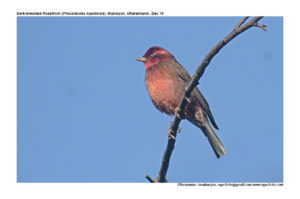
Dark-breasted Rosefinch Carpodacus nipalensis
Etymology:
Nominate
- Carpodacus : Greek word karpos- fruit; dakos –biter { Fruit eater/biter}
- Nipalensis : From Nepal
Subspecies:
- C.n. kangrae : From Kangra, in Himachal Pradesh in India
Vernacular Names: Lepcha: Ka-biya
Distribution in India:
- Nominate – Central & East Himalayas from Nepal to North East India ( Arunachal Pradesh)
- C.n. kangrae – West Himalayas in North India (Himachal Pradesh and Uttarakhand, Kashmir)
Description: Size of 15–16 cm; wt. of 20–24 g. It is a medium-large, dark Rosefinch with pointed conical bill and notched tail. The male of nominate race has lowermost forehead and lores as black, continuing as broad dark maroon eyestripe to side of neck. The forehead and forecrown are deep vinous-pink, bright pink supercilium behind eye, bright pink on cheek and ear-coverts extending to chin and throat. The crown, nape and upperparts are dark maroon, indistinctly streaked darker. The tail is blackish-brown, finely edged dull reddish-brown. The upperwing is dark brown, tinged crimson, paler or brighter on edges and tips of greater coverts, flight-feathers are edged dull crimson, tertials are broadly edged slightly paler or pinkish-white. The side of lower throat to upper belly and flanks are maroon, rest of underparts are pinkish or tipped crimson. The iris is black; bill is dark brown, lower mandible has paler flesh-brown base; legs are flesh-brown. The female has forehead to crown, nape and upperparts as dark brown, broadly but indistinctly streaked darker, rump and uppertail-coverts are paler buff-brown. The tail is dark brown, edged warm buff-brown, wing is dark brown. The median and greater coverts are tipped pale buff-brown, secondaries are edged paler brown or buffish, and tertials are broadly tipped pale buff-brown. The face and underparts are dull buffish-brown, sometimes poorly defined pale supercilium; belly to undertail-coverts are slightly paler; bare parts as for male. The juvenile is like female, but upperparts more uniformly olive-brown. The first-winter and first-summer males as adult female, but may show some reddish-brown on upperparts towards end of first summer. Race kangrae is similar to nominate, with upperparts browner, female paler and greyer than nominate.
Habitat: It is found in montane or submontane oak, fir and rhododendron forests, scrub, stunted bushes, grassy slopes and weed patches, patches of bamboo, also among rocks in boulderfields, alpine meadows at or above tree-line and ravines. It is found from 3000m to 4400 m in breeding season. In non-breeding season occurs in forest clearings and edges, undergrowth and edges of cultivation at lower levels, 900m to 2500m.
Food Habits: It eats small seeds and berries, blossom, pollen and nectar from rhododendron flower heads , its forehead and throat becomes stained with pollen. It actively forages on the ground. It is shy, found under bushes or low vegetation. It is found in pairs or small flocks and in mixed-species flocks with Crimson-browed Finch, Gold-naped Finch or Scarlet Finch.
Breeding habits: They breed Jun–Aug